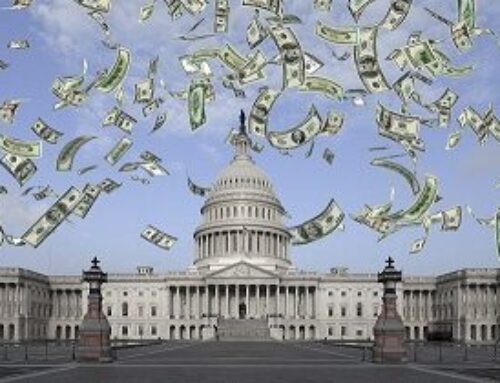WASHINGTON – The price tag of President Joe Biden’s plan for a massive expansion of the nation’s social programs remains a subject of negotiations in Congress.
But no matter the final number, Biden insists the true cost will be zero.
“The fact of the matter is, my Build Back Better Agenda costs $0 — and it won’t raise taxes on anyone making under $400,000 a year,” Biden tweeted on Monday. “We’re going to pay for it by ensuring those at the top and big corporations pay their fair share.”
Republicans accuse Biden of lying.
“He is very confused,” Sen. Tom Cotton, R-Ark., wrote on Twitter.
Who is right?
Budget analysts say it would be possible for congressional Democrats to piece together a bill that would have a net cost of zero. Tax increases on corporations and wealthy Americans could theoretically raise enough revenue to offset the cost of expanding social and climate change programs, they said.
But the current bill that is the basis for negotiations among House Democrats doesn’t achieve that goal. That proposal would enact $3.5 trillion of spending increases and tax breaks and about $2.9 trillion of tax increases and health care savings to offset the cost, leaving a roughly $600 billion hole, according to the nonpartisan Committee for a Responsible Budget.
What’s more, the spending and tax breaks could cost as much as $5 trillion or $5.5 trillion, far short of the $2.9 trillion in offsets, the organization said.
Final net cost of bill remains unknown
Biden and Democrats are negotiating to lower the package’s price tag to between $1.5 trillion and roughly $2.2 trillion to appease moderates who are concerned about the overall cost. Whether the net cost will be zero or higher depends on the final price tag and which offsets remain in the package.
If negotiators lower the cost to around $2 trillion and keep the proposed offsets from the House, “then the net cost could be zero,” said Marc Goldwein, senior vice president and senior director of policy of the Committee for a Responsible Federal Budget.
But, “we won’t know the final net cost until we see the bill,” Goldwein said.
Taxing corporations and the wealthy
The package of social programs and climate change initiatives is the heart of Biden’s Build Back Better agenda and one of Democrats’ top legislative priorities. The far-reaching package includes proposals for free community college, universal prekindergarten, subsidized child care and national paid leave.
Biden has proposed spending $3.5 trillion on the package over 10 years, although that number is at the center of the ongoing negotiations between congressional Democrats.
Biden and the Democrats intend to pay for the program expansions through a series of tax increases on corporations and wealthy Americans.
Under the current proposal, the top tax rate for corporations would jump from 21% to 26.5% on incomes beyond $5 million. Biden had originally suggested raising the corporate tax rate to 28%, but Democrats and some corporations objected.
The top tax rate on individuals earning more than $400,000, or $450,000 for couples, would revert to 39.6% from the current 37%. People who make more than $5 million a year also would face a 3% surtax.
The top tax rate for capital gains – money earned from the sale of stocks or property – would jump to 25% from the current 20%.
Raising taxes on corporations and Americans earning more than $400,000 a year, negotiating the price of prescription drugs and tapping into other sources of federal revenue would enable the administration to offset the cost of the massive expansion of social programs and Biden’s climate change proposals, the White House and Democrats argue.
Republicans, however, insist the $3.5 trillion in spending set by Democrats is fiscally reckless and big government at its worst.
“The radical left is pushing in all their chips – they want to use this terrible but temporary pandemic as a Trojan horse for permanent socialism,” said Senate Republican leader Mitch McConnell of Kentucky. “Trillions upon trillions more in government spending when families are already facing inflation.”
‘A lot of assumptions’
It’s not entirely clear whether Biden’s claim of “zero” cost is feasible under the 10-year outlook used by the Congressional Budget Office to assess the economic impacts of legislation.
Biden’s own budget officials earlier this year estimated that his agenda would increase the national debt by nearly $1.4 trillion over the decade. The true impact won’t be known until the bill is finalized, and the measures are assessed by the Congressional Budget Office, the final arbiter of how the legislation will affect the federal balance sheet.
Even then, “there are just a lot of assumptions,” said Joshua Sewell, senior policy analyst at Taxpayers for Common Sense, a nonpartisan budget watchdog group.
The impact of spending proposals is usually assessed, or scored, over 10 years. But the health of the economy over a decade can be affected during unforeseen events.
Nobody could have predicted last year’s recession caused by the coronavirus pandemic. Likewise, forecasters were predicting a budget surplus when Republicans passed tax-cut legislation in 2001. Then 9/11 occurred, “and that clearly wiped away any surplus that was ever going to happen,” Sewell said.
Budget projections “are subject to reality” and may prove to be inaccurate, Sewell said.
In some ways, the claim that the Build Back Better agenda will cost nothing is an argument over semantics, Sewell said.
“The federal budget is not like a family’s budget, but it’s still subject to the laws of accounting and basic math,” he said. “So if you’re saying that the Build Back Better agenda or this specific bill costs nothing, well that’s not true.”
Even if there is enough revenue in the bill to pay for the programs, there is still a cost, Sewell said.
“If you have an income that allows you to buy lunch, and you pay for it with your income, your lunch still costs you $10 to buy a cheeseburger,” he said. “You just didn’t have to borrow from your uncle to pay for it.”
On the other hand, if the claim is that the bill would not add any cost to the federal deficit, that is a different argument, he said.
“If those projected outlays or that projected spending happens and the projected income happens, the net cost in deficit financing could be zero,” Sewell said. “It’s certainly plausible.”
Michael Collins cover the White House. Follow him on Twitter @mcollinsNEWS.
Contributing: The Associated Press











Get Social